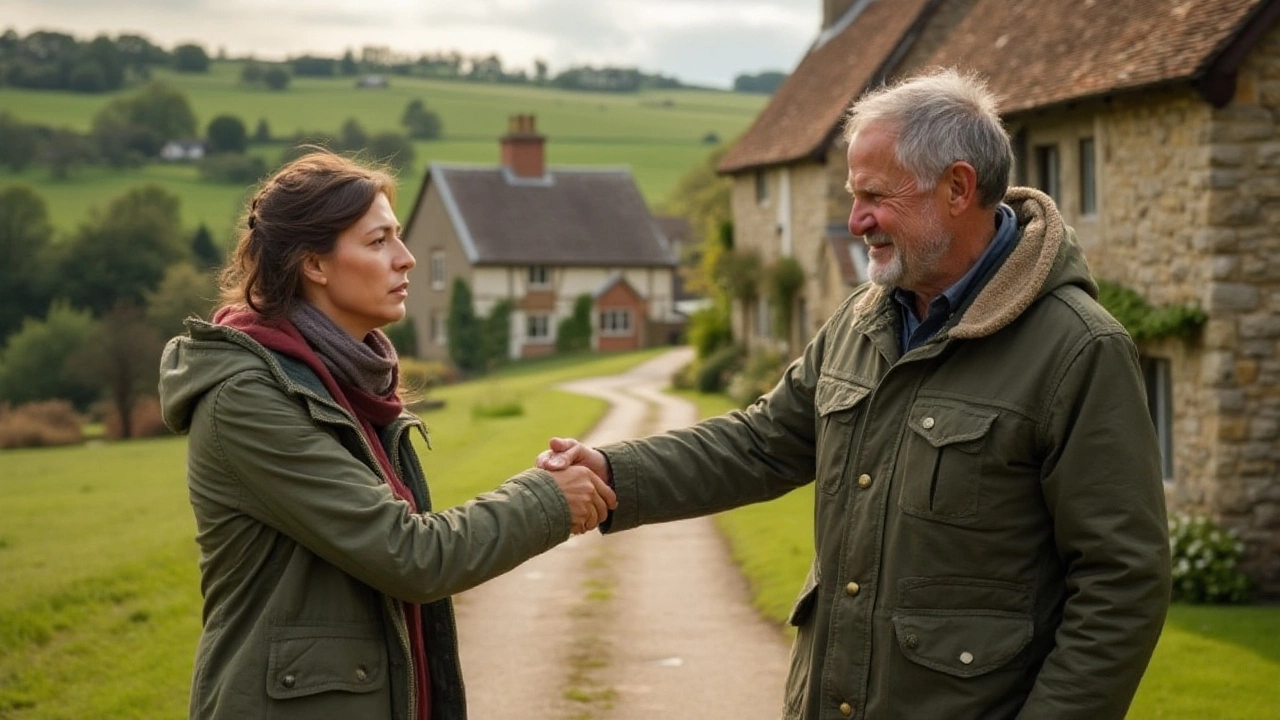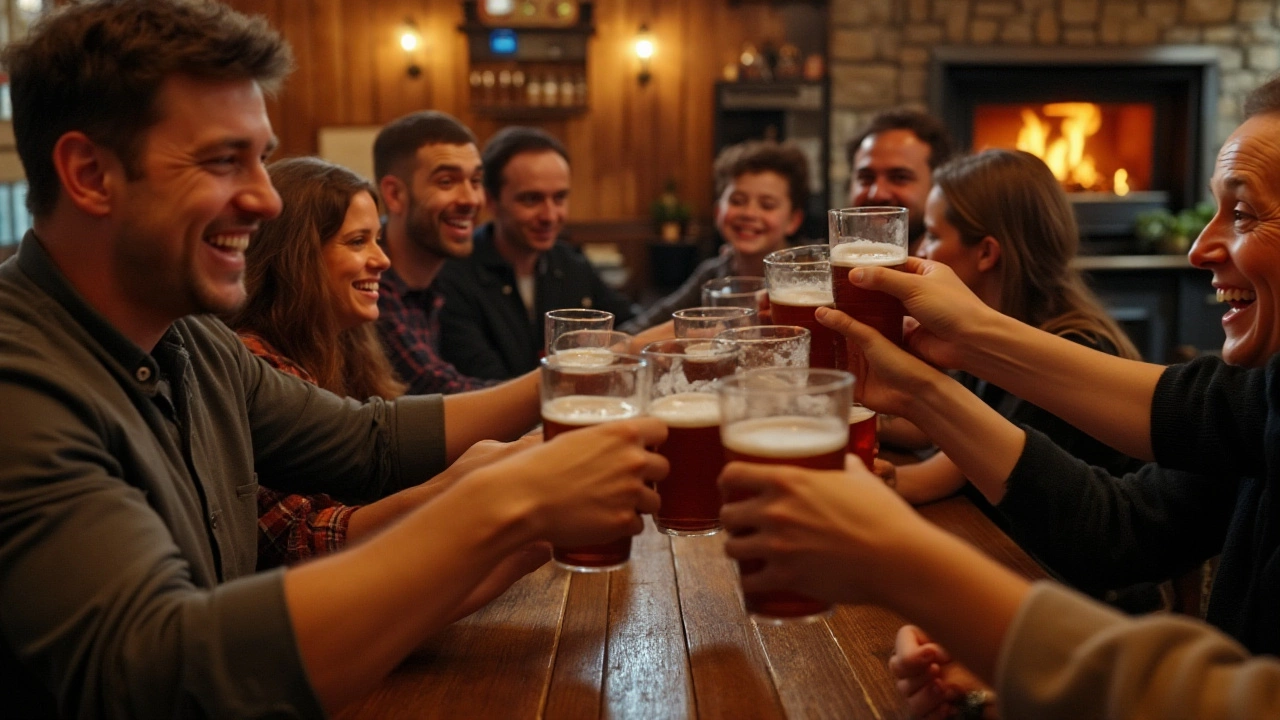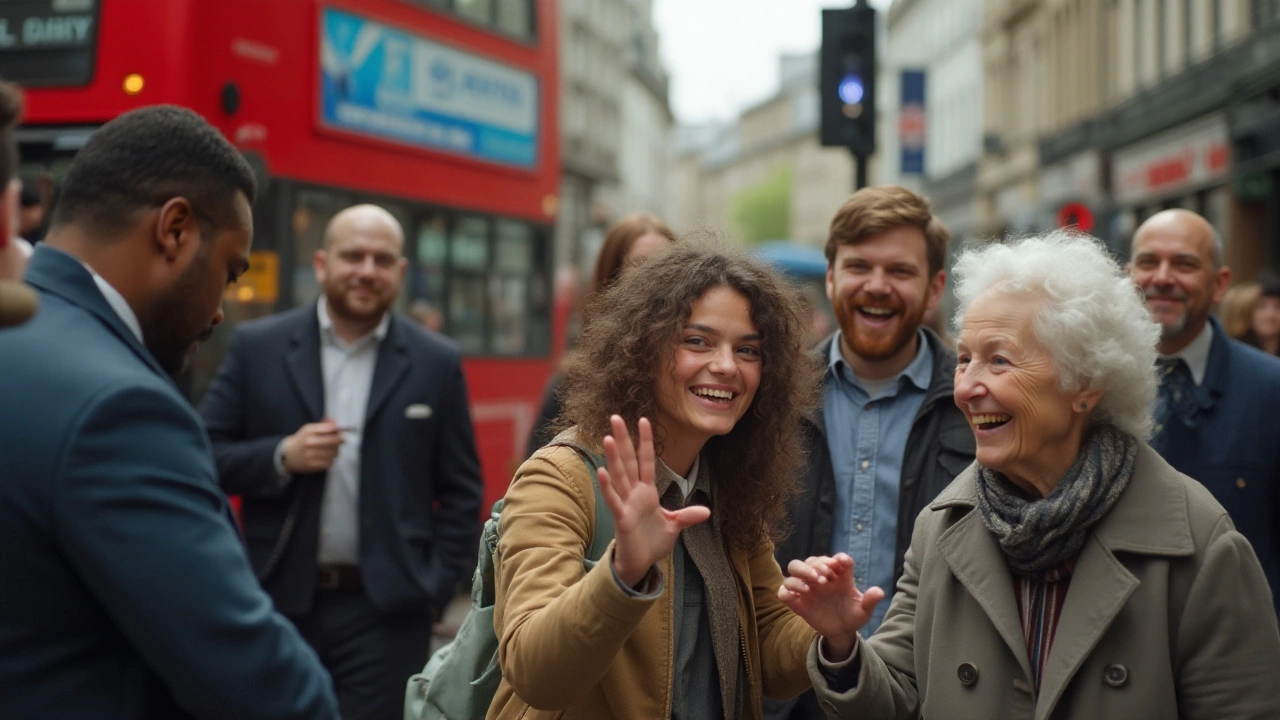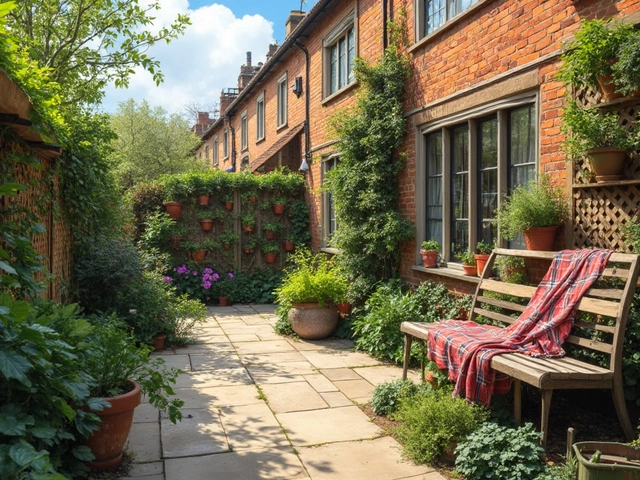When traveling through the United Kingdom, one quickly learns that greetings are an intrinsic part of its vibrant culture. Brimming with subtleties and regional idiosyncrasies, the way Brits say 'hello' can reveal much about their social customs and longstanding traditions.
From a formal nod accompanied by 'How do you do?' to a casual 'Alright?', greeting conventions may vary depending on where you find yourself. Whether it's a bustling street in London or a quaint village in Yorkshire, understanding the local manner of saying 'hi' can lead to more meaningful connections.
So, if you’re setting foot on this charming island, grasping these cultural tidbits will surely enhance your experience, enabling you to navigate gracefully through social scenarios like a true Brit.
- Traditional Greetings Through History
- The Informal Side: Common Everyday Hellos
- Handshake or Hug? Physical Gestures Explained
- Regional Differences You Should Know
- How Seasons and Holidays Affect Greetings
- Tips for Travelers: Making a Good Impression
Traditional Greetings Through History
When exploring the landscape of British social customs, one is bound to encounter the rich tapestry of traditional greetings that have evolved across the centuries. These gestures and verbal cues tell tales of an ever-shifting culture, steeped in the influences of the past and shaped by historical events. In medieval England, formal greetings were laden with ceremony. Men and women of noble heritage would greet each other with a profound bow or curtsy, signifying respect and adherence to the societal hierarchy of the time. This was not merely an exchange of pleasantries, but often a reaffirmation of one's social standing and the recognition of another's nobility.
As Britain sailed through the Elizabethan era, the handshake emerged as a common practice among gentlemen, symbolizing honesty and trust. This tactile greeting was said to have roots in the ancient Roman tradition where one would grasp the forearm of the other to check for concealed daggers. With the age of enlightenment and trade expansion, the British Isles became a melting pot of cultural influences, enriching the tapestry of its social communications.
The Victorian period brought with it an air of formality once again, where ladies and gentlemen held elaborate formal greetings as a reflection of their education and sophistication. The phrase “How do you do?” became widespread as a standard greeting amongst those in higher social strata. It was an expression not intended to solicit an actual account of one’s well-being but served more as a polite acknowledgment of someone’s presence. It’s quite revealing that such phrases have persisted over time, forging the essence of British customs.
The influence of British colonialism cannot be overlooked as it played a pivotal role in shaping the ways of greeting in subsequent centuries. The globe-trotting British Empire contributed to spreading its etiquette across continents, blending with and often dominating local customs. Yet, in the midst of these historical shifts, regional diversity remained markedly intact. From Yorkshire to Cornwall, different areas developed not only unique dialects but also distinct greetings that continue to this day.
The Evolution of Greetings
In examining the evolution of British greetings, one cannot ignore the literary reference that captures the essence of the era. As Shakespeare penned in his play “Hamlet,” the phrase "Good morrow" was commonly used as a morning salutation in the 16th century. This poetic exchange was indicative of the period's creativity and rich linguistic heart. A nod to the importance of greetings can be found in the words of English writer Samuel Johnson, who noted in his dictionary, "A good greeting is at times better than a good breakfast."
Cultural observer, Jane Austen, often emphasized the nuances of greetings in her works. In ‘Pride and Prejudice,’ she articulated how greetings often decipher social codes and pure intentions, a thin veil between courteous civility and genuine warmth.The diversity of British greetings mirrors the multifaceted history of this ever-evolving nation. Whether etched in the pages of classic literature or carried in the voices of a bustling modern city, these age-old traditions are testament to the timeless nature of human connection.
The Informal Side: Common Everyday Hellos
In the realm of British greetings, the charm often lies in simplicity and informality, reflecting a rich tapestry of everyday interactions. While the British might be stereotyped as reserved, their greetings can be surprisingly warm and personable. When exploring the streets of bustling cities like London or cozy towns in the countryside, one might notice that saying 'hello' is often accompanied by a genuine smile—a quick, universal way to break the ice. The familiar 'hi' or 'hello' is commonly used across all ages and social groups, proving to be a versatile greeting that fits nearly all contexts.
An interesting informal greeting you’ll encounter quite frequently is 'Alright?' which serves as both a question and a greeting, reflecting an unspoken understanding that the addressee is expected not to delve into a detailed account of their wellbeing, but rather a simple 'not bad, thanks' will suffice. Such exchanges highlight the British value of being subtly polite while maintaining a sense of personal space. In more casual settings, friends might even greet each other with a jovial 'Hey there!' or 'Yo!'—expressions that blend the local vernacular with an ever-changing world.
As noted by Dr. John Wilson, a cultural historian, "In Britain, greetings have evolved subtly over time, yet they maintain an essence of connection—one that speaks volumes without requiring words."
When stepping into a pub or local café, you may witness the phrase 'How’s it going?' exchanged frequently. This informal inquiry provides a foundation for beginning a light-hearted conversation. Surprisingly, it acts as both a greeting and a conversation starter—a true testament to the British love for chatting over a cup of tea or pint of ale. While seemingly mundane, these informalities capture the essence of British civility and warmth. One might notice the tone varies based on familiarity—where a chuckle or friendly pat on the back among mates adds texture to the standard greeting.
Intriguingly, the world of British greetings doesn’t overlook the charming endearments. Terms like 'love,' 'duck,' or 'mate' often feature in informal salutations—especially in regions such as the North of England or the Midlands. These affectionate nicknames are used broadly without specific regard to gender, showcasing how endearments add a touch of warmth and regional flavor to everyday interactions. For travelers, adopting these greetings offers an intimate glimpse into local life, presenting them as more than mere tourists.
| Popular British Informal Greetings |
|---|
| Hi/Hello |
| Alright? |
| How’s it going? |
| Hey there! |
| Yo! |
With so much diversity in greetings, from the cosmopolitan shuffle of Londoners to the friendly nods of Cornish locals, understanding these nuances ensures a seamless connection with the people of this vibrant nation. By adopting these informal greetings and absorbing the cultural etiquette, you position yourself as a more mindful traveler ready to engage in genuine dialogue. So whether sharing a moment at the bus stop or navigating a bustling market, remember that a sincere, rhythmically British 'hi' can open doors to the local culture and the warm hearts of its people.

Handshake or Hug? Physical Gestures Explained
Navigating the realm of British greetings involves more than simply choosing the right words; understanding the physical gestures that accompany these greetings plays a crucial role too. In the UK, the classic handshake remains a staple in formal and semi-formal settings. A firm but not overpowering handshake is often the go-to for introductions, especially in business environments or when meeting someone for the first time. While handshakes are common, the nuances—such as eye contact and a warm smile—add a layer of familiarity and trust to the exchange.
Conversely, the notion of hugging can be quite a divisive topic among Brits. Unlike in many other cultures where hugs might be a standard form of greeting among friends, the British tend to reserve hugs for more personal relationships. It's not unusual for a brief, light embrace to occur between close friends or family. However, within professional or casual acquaintances, the handshake predominates. This doesn’t imply a lack of warmth, but rather an adherence to a form of reserved politeness that is rather emblematic of British customs.
"A hug is like a warm handshake from the heart which can nurture relationships," says etiquette expert Anna Musson, though she highlights that context is key in deciding the right moment for a hug.
Interestingly, the practice of cheek-kissing, often associated with European customs, has gained ground, particularly in metropolitan areas like London. Yet, confusion sometimes reigns over whether one kiss, two, or even three is customary. Generally among the British, a single kiss on the cheek is appreciated, but caution should be exercised, especially in unfamiliar settings. The embrace of kissing as a greeting reflects the UK's evolution towards more continental influences, though the degree of acceptance can vary significantly depending on the person's background and the region.
Age and personal preference further complicate the landscape of physical greetings in the UK. Younger individuals may be more inclined to adopt less traditional gestures that align with global trends, such as the fist bump or quick hug. However, older generations might lean more toward the steadfast handshake. In some settings, a simple nod or smile can suffice, highlighting the importance of reading the room and gauging comfort levels accurately.
For travelers keen to fit in while respecting local customs, understanding these physical gestures can significantly impact a first impression. Keen awareness and adaptability are vital, as is the willingness to engage in the delightful dance of social interaction that marks British society. Remember, when in doubt, a well-placed and sincere handshake never fails to pave the way for positive encounters and deeper connections.
Regional Differences You Should Know
In the kaleidoscope of accents and traditions that is the United Kingdom, British greetings are no exception to the rich tapestry of regional variety. Travel from the north to the south, and you'll quickly discover that what works as a friendly hello in one region might be met with puzzled looks in another. Let's start with the north, where a warm 'Ay up' or 'Eh up' greets you in places like Yorkshire and Derbyshire. It's a no-nonsense acknowledgment that reveals the community-centric heart of these regions where everyone seems to know everyone else. Further north, in the likes of Scotland, you might hear 'Fit Like?' — a succinct way of asking how you're doing, reflective of the direct nature of its people.
As you make your way to Wales, the greetings become bilingual with a charming 'Shw'mae?' (pronounced shoo-my) inviting you into Welsh discussions. The Scottish islands sometimes offer 'Madainn Mhath' as a friendly morning salutation, capturing the essence of their proud Gaelic heritage. Down south, in contrast, you'll find a simple 'Alright?' or 'How's it going?' among the staple greetings. These phrases imply a sense of camaraderie and informality distinctive to areas like London and the West Country, projecting the relaxation found within British cities.
A quintessential aspect of the UK is its ability to adapt greetings to folk’s personal familiarity. In every region, it's common to alter tone and formality depending on whether you're meeting friends, family, or strangers. The east of England, for example, often surprises with a lighthearted 'Oi oi' as friends gather at a local pub. This engaging interaction underlines how cultural etiquettes shift across different environments, emphasizing the UK's social fabric. As The Guardian once noted, "To understand British greetings is to peek into the subtle yet profound way we connect with one another." Tradition and history play key roles here, as many greetings date back generations — carrying with them echoes of local dialects and historical evolutions.
Greetings Etiquette: Tips for Each Region
Visitors should remember that while smiles are universal, a thoughtful greeting often opens doors. In northern England, where community bonds run deep, using local lingo with sincerity is welcomed warmly. When in Scotland, a slight nod of the head accompanies friendly local phrases, whereas in the south, casual expressions are perceived as an equalizer in social settings. The nuances in gestures show respect and interest, qualities that the British find admirable in travelers. Understanding these British customs can enrich your journey, offering you a deeper engagement with the land and its people.The diversity in greetings can be akin to the landscape changes you might experience on your travels, each unique, each offering a reflection of the place you're in. So, on your next adventure to the UK, embrace these differences; they are the keys to understanding a culture that values subtlety and shared tradition.

How Seasons and Holidays Affect Greetings
As the seasons change, so do the ways in which people in the UK greet each other, adding an intriguing layer to their rich and diverse culture. From the bright, cheerful exchanges commonly heard in spring to the more reserved, cozy tones of winter, the way British greetings are flavored by the time of year is fascinating. For instance, during springtime, when the country bursts into color with blossoming trees and flowers, greetings often reflect renewed energy and optimism. It’s not unusual to hear people say ‘Lovely weather today, isn't it?’ in place of the usual ‘Hello’ or ‘Hi’.
In the summer months, especially during annual events like Wimbledon or the Chelsea Flower Show, greetings take on an even more jovial tone. Striking up conversations over the weather or local festivities becomes common practice, making social interactions feel even more vibrant and lively. As autumn arrives, with its muted landscapes and cooler temperatures, greetings become a bit more subdued. People might bring up the crisp weather or the anticipation of upcoming holidays in their exchanges, giving these interactions a sense of warmth and community.
Winter introduces perhaps the most notable variations in greetings due to the holiday season. Christmas and New Year’s celebrations bring out specific traditional phrases like 'Merry Christmas' and 'Happy New Year,' which replace standard greetings from mid-December onwards. This time of year is also when you might hear well-wishing phrases like ‘Stay warm’ or ‘Enjoy the holidays,’ reflecting the spirit of goodwill prevalent during this period. The significance of these greetings extends beyond mere words, as they imbue everyday life with cultural richness and personal connection.
Additionally, British greetings are influenced by a variety of bank holidays and cultural events. For example, around Guy Fawkes Night, you might catch people referencing the infamous plot in their interactions. These changes indicate not only the time of year but also an acknowledgment of shared history and traditions, which are deeply embedded in British customs. Emphasizing these unique aspects can deeply enhance any traveler’s experience, providing them with a richer understanding of their surroundings and enabling stronger connections with locals.
Understanding how these British customs fluctuate with the changing seasons and holidays can offer tourists a more immersive experience. It lends insight into not just regional but also temporal cultural nuances. So, as you plan your visit, pay attention to the calendar as much as the map, and you might find every 'hello' turning into a conversation teeming with cherished traditions and anecdotes shared by those you meet.
‘The British themselves are generally amicable, and they'll undoubtedly greet you with enthusiasm during spirited seasons like summer and Christmas.’
Tips for Travelers: Making a Good Impression
When setting foot in the UK, making a good first impression starts with mastering the art of greeting. Knowing the appropriate way to say 'hello' can be a gateway to warm interactions and smooth engagements. Most importantly, it's essential to observe the social setting and follow the lead of those around you. Whether you're in a formal meeting or a casual pub setting, adapting your greetings can help you blend in. Remember, the British are known for their politeness, so initiating a greeting with a smile and respectful body language is key. You may find that a simple nod or a 'hi' is more suitable in an informal context, while a handshake can convey professionalism in more serious settings. Watching the locals is perhaps the best lesson one could get in this regard.
Using the correct verbal expressions is significantly crucial for thriving in British society. While saying 'good day' might seem right, keep in mind that common phrases like 'hello', 'hi', or even 'cheers' are often used, depending on the situation. In the North, you'd be greeted with a friendly 'hiya,' while in more refined circles, you might encounter a 'good morning.' The key is to reciprocate the greeting with the same energy and warmth. Listening plays an excellent role, especially if you're keen to use expressions appropriately. It could be as simple as repeating the phrase with a jovial tone or mirroring the sentiment behind it.
Physical gestures, such as handshakes or hugs, add another layer to greetings. Typically, handshakes are restrained for formal events. However, in the newfound era post-2020, some prefer not to engage in physical contact, primarily due to health concerns. Respecting personal space is always a considerate approach. When it comes to hugging, it's crucial to ascertain first if it seems comfortable for the other person too. Remember that hugs are more common among friends and family rather than acquaintances.
"British politeness isn't just a stereotype; it's a social code," notes Alexander Smith in his book on European cultural etiquette.
For travelers, the key to forging an authentic connection with the locals is to exhibit curiosity and express humility while interacting. Asking questions and showing interest in their culture goes a long way. Don't shy away from enquiring about local customs, as this will not only enrich your experience but also win you favor among your British hosts. A dash of curiosity combined with respect is indeed a perfect recipe. Equally, being careful with your words and tone ensures you never come across as brusque or forward during first encounters.
Emphasizing the importance of cultural awareness, imagine landing in Wales with plans to visit a local pub. Once inside, you notice everybody greeting with the phrase 'Iechyd da!' rather than 'cheers.' Understanding such nuances can not only save you from awkward situations but also earn you a smile and acceptance from the community. Subsequently, some traveler anecdotes report how a kind attempt to use local slang, even if not perfect, tends to flicker a welcoming smile in return. Such experiences enrich one’s travel story, adding layers to every conversation and encounter.





